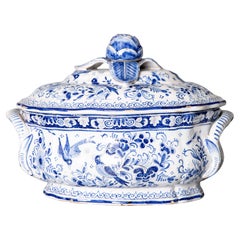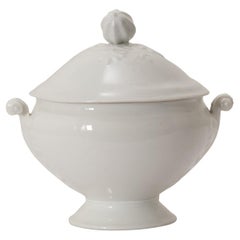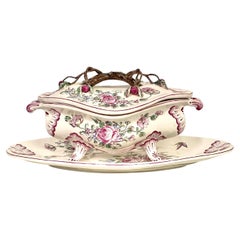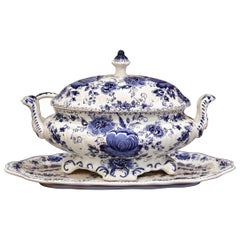Delft Soup Tureens
to
1
1
1
1
1
1
1
1
1
1
1
126
13
13
11
6
Creator: Delft
18th Century Antique Dutch Delft Faience Lidded Tureen
By Delft
Located in Pearland, TX
A superb antique Dutch Delft faience lidded soup tureen. Maker's mark on reverse featuring an axe or hatchet, denoting it's factory, De Porceleyne Bijl (The Porcelain Axe), active 16...
Category
18th Century Dutch Louis XV Antique Delft Soup Tureens
Materials
Porcelain
Related Items
French Ironstone Lidded Tureen
Located in Baton Rouge, LA
A gorgeous antique French white porcelain lidded soup tureen with pedestal base, perfect for serving soups, stews, and gumbos.This fine soup tureen has a decorative acorn squash fini...
Category
20th Century French French Provincial Delft Soup Tureens
Materials
Porcelain
19th Century Faience Soup Tureen with Lid & Platter, Hand-Painted
Located in LA CIOTAT, FR
This stunning antique French soup tureen is a true masterpiece of 19th-century faience craftsmanship. Complete with its original lid and underplate, the set is richly adorned with ha...
Category
19th Century French Antique Delft Soup Tureens
Materials
Ceramic, Faience, Majolica, Paint
$1,020
H 7.88 in W 19.1 in D 13.39 in
Antique 18th Century Dutch Delft Chinoiserie Plate
By De Grieksche A, Delft
Located in Philadelphia, PA
A fine antique Dutch Delft plate.
Depicting a man and fence in the foreground and a background with a house, a tree, an island with a build...
Category
18th Century Dutch Baroque Antique Delft Soup Tureens
Materials
Delft
5 Ironstone Tureens with Lids
Located in New Orleans, LA
A lovely collection of 5 white tureens with Lids. EACH ONE IS UNIQUE. The sizes ranges from 11 – 12 diameter to 10 – 12 High. This set would be the perfect start to a kitchen sideboa...
Category
19th Century French Antique Delft Soup Tureens
Materials
Ironstone
19th Century English Derby Porcelain Tureen with Lid
By Derby
Located in Atlanta, GA
19th Century English Derby Porcelain Tureen with lid.
Category
19th Century English Antique Delft Soup Tureens
Materials
Porcelain
Chinoiserie Dutch Delft Polychrome Faience Lobed Jar, 18th Century, Holland
By Delft
Located in Austin, TX
A charming Dutch Delft ginger jar of lobed form, with chinoiserie design in polychrome tin glazed enamels, 18th century, Holland.
The ginger jar (missing its lid), of globular fo...
Category
Late 18th Century Dutch Chinoiserie Antique Delft Soup Tureens
Materials
Earthenware, Faience
Mid 18th Century Chinese Export Soup Tureen with Under Plate
Located in San Diego, CA
A very nice mid 19th century Chinese export porcelain soup tureen with under plate, circa 1850s. The stand is in very good vintage condition with no chips or cracks and measures 14.5...
Category
Mid-19th Century Chinese Chinese Export Antique Delft Soup Tureens
Materials
Porcelain
$3,160 Sale Price / set
20% Off
H 10 in W 14.5 in D 11.25 in
German 19th Century Meissen Porcelain Lidded Tureen
By Meissen Porcelain
Located in West Palm Beach, FL
A charming German 19th century Meissen Porcelain lidded tureen. The oblong shaped tureen displays beautiful finely detailed hand painted blooming flower...
Category
19th Century German Antique Delft Soup Tureens
Materials
Porcelain
Antique 18th Century Polychrome Dutch Delft Plate
By Delft
Located in Philadelphia, PA
A fine antique 18th century Dutch Delft plate.
With painted floral decoration throughout in orange, purple, blue, and yellow.
Simply a wonderfu...
Category
Mid-18th Century Dutch Baroque Antique Delft Soup Tureens
Materials
Delft
Large Blue and White Porcelain Soup Tureen French 18th Century
By Arras Foundry
Located in Katonah, NY
Decorated with an elegant design of delicate blue cornflower sprigs, this soup tureen was made by Arras Porcelain in Arras, France, in the late 18th century.
The cornflower sprigs, handles, and border edging are decorated with beautiful deep twilight blue enamel.
The makers of Arras Porcelain specialized in porcelain painted in this entrancing blue called "Bleu d'Arras."
The color of the porcelain body is creamy white.
The combination of the creamy white ground and the blue decoration is splendid.
Natural forms like the tree branch handle and the blue cornflower decorations were the height of French fashion in the last quarter of the 18th century.
Made at the Arras porcelain factory of the Delemers family circa 1780, the tureen and its stand are marked in underglaze blue.
Dimensions:16" wide x 13" deep x 9.5" tall
Condition: Excellent, with some hard-to-see rubbing to the clear glaze on the stand
Price: $1,520
The underside of the tureen is marked with the letters "AR" for the Delemers family Arras factory.
The underside of the stand is marked "Dele AR" for the Delemers family Arras factory.
On 1stdibs, we also have a matching round tureen Item Reference LU866530033982
Background of Arras Porcelain:
The Arras Porcelain factory was started in the 1770s by the family Delemers.
They were a family of four sisters...
Category
Late 18th Century Louis XVI Antique Delft Soup Tureens
Materials
Porcelain
Antique Blue and White Mennecy Porcelain Tureen Mid-18th Century France Ca. 1750
By Mennecy Porcelain Manufactory 1
Located in Katonah, NY
This delightful 18th-century blue and white porcelain tureen was hand-painted at the Mennecy Porcelain factory in France circa 1750.
Loose flower sprigs painted in cobalt blue decora...
Category
Mid-18th Century French Antique Delft Soup Tureens
Materials
Porcelain
$1,100
H 5.5 in W 10 in D 6 in
Sheffield Soup Tureen with Handles and Lid, Late 19th Century
Located in Savannah, GA
Sheffield soup tureen with handles and lid, late 19th century.
Category
19th Century English Antique Delft Soup Tureens
Materials
Silver Plate
Previously Available Items
Mid-Century Painted Blue and White Delft Tureen with under Platter and Ladle
By Delft
Located in Dallas, TX
Decorate a dining table with this elegant antique faience dish. Crafted in Holland circa 1950, the centerpiece includes an oval tureen with side handles and open lid, the oval under ...
Category
Mid-20th Century Dutch Delft Soup Tureens
Materials
Faience, Porcelain
Delft soup tureens for sale on 1stDibs.
Delft soup tureens are available for sale on 1stDibs.
Questions About Delft Soup Tureens
- What is Delft known for?1 Answer1stDibs ExpertApril 5, 2022Delft is known for its blue ceramic pottery called Delftware. Artisans in the Dutch city began producing the earthenware during the 16th century. In addition, Delft is the home of the 17th-century Dutch Baroque painter Johannes Vermeer. You'll find a range of Delftware on 1stDibs.
- 1stDibs ExpertOctober 7, 2024The difference between Delft and Chinoiserie is that one is a specific type of pottery, and the other is a style of pottery. Chinoiserie is a general term for pottery and other decorative objects produced by Western artisans that draw inspiration from traditional Chinese functional and fine arts. Delft, or Delftware, is tin-glazed pottery made through techniques that originated in Delft, Netherlands. Many pieces of Delftware are examples of Chinoiserie because their decorative embellishments were inspired by Chinese porcelain. On 1stDibs, explore a selection of Delftware and Chinoiserie pottery.
- 1stDibs ExpertMay 3, 2024To tell how old your Delft is, look for the maker's markings. On most pieces, you will find the painter's initials as well as a two-letter date code. By comparing the date code on your piece to information provided on trusted online resources, you can find out its year of production. If you have trouble locating the date code, a certified appraiser or knowledgeable antiques dealer can assist you with dating. Explore a diverse assortment of Delft pottery on 1stDibs.
- How can I tell if Delft is real?1 Answer1stDibs ExpertApril 5, 2022To tell if Delft pottery is real, look at it under a magnifying glass. Authentic Delftware should show visible brushstrokes, a sign that the pieces have hand-painted images. You can also turn the piece over and look for a crown cross marking with the words Handpainted, Delft Blue, Made in Holland. On 1stDibs, find a collection of expertly vetted Delft pottery.
- When were Delft tiles made?1 Answer1stDibs ExpertMarch 22, 2022Delft tiles were made during the 17th and 18th centuries. The term refers to earthenware tiles with tin-glaze finishes that were meticulously hand-painted by artisans living in the city of Delft in what is now the Netherlands. Find a selection of Delft tiles on 1stDibs.
- 1stDibs ExpertApril 5, 2022Yes, Delft tiles are still being produced. Delft pottery, also known as Delftware or Delft Blue, refers to a tin-glazed earthenware crafted in the city of Delft in the Netherlands. Delftware is highly coveted due to the intricate nature of the design and is a favorite among home decor enthusiasts. Shop a wide range of authentic Delftware on 1stDibs.
- How much is Delft pottery worth?1 Answer1stDibs ExpertSeptember 16, 2024How much Delft pottery is worth varies based on characteristics like type, style, age and condition. Selling prices usually start in the low hundreds, with the most valuable examples of Delft pottery worth $10,000 or more. True blue Delftware originates only from a single location: Delft in the Netherlands. These precious pieces pair well with French faience. Unlike Delftware, French faience utilizes a lead-and-tin glaze. To find out how much a specific piece is worth, have a certified appraiser or knowledgeable antique dealer evaluate it. On 1stDibs, shop a large selection of antique Delft pottery.
- Is Delft Blue still made?1 Answer1stDibs ExpertApril 5, 2022Delft Blue is in fact still made today. There is one factory left, the Royal Dutch, which has been in operation since 1653. It continues to make delft blue using the traditional methods. You’ll find a variety of Delft blue products from some of the world’s top sellers on 1stDibs.
- 1stDibs ExpertSeptember 23, 2024To identify your Delft pottery marks, try using the factory mark database on the Delfts Aardewerk platform. Several Dutch museums joined forces to create this site in order to educate the public and collectors about Delftware. On it, you'll find hundreds of pictures of makers’ markings and a handy search feature for browsing the images based on a description of your marking. If you're unable to find your mark on the site, a certified appraiser or knowledgeable antique dealer can aid you with making an identification. Explore a selection of Delft pottery on 1stDibs.
- 1stDibs ExpertFebruary 22, 2021Delftware often has a maker's mark on the base or back of the item consisting of letters or figurative symbols to show where the item was manufactured. Today markings will say hand-painted in Holland as well as the phrase Delft blue in Dutch or English.



